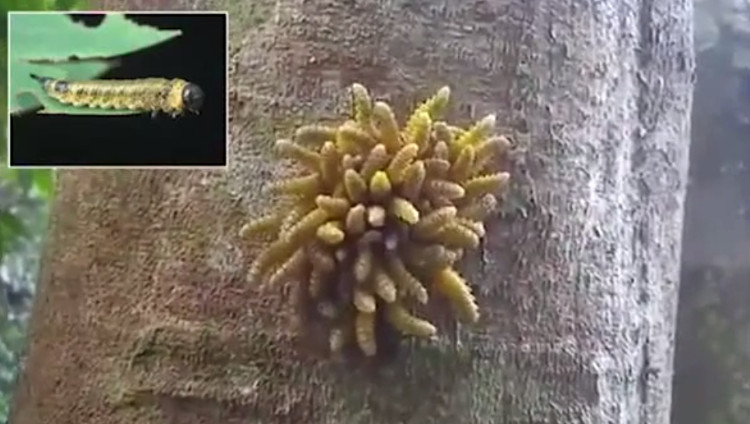The larvae are snuggled into a big tuft for self-defense
A leaf bee larvae bunched their heads together into a mass on a tree trunk in Peru to survive the predator's attack.
Bee larvae bite leaves clumping together, only revealing a wiggling head. The 26-year-old biologist Aaron Pomerantz, a graduate student at the University of California, Berkely, USA, witnessed the behavior of this larvae in the Amazon rainforest near Tabopata, Peru, last month, according to Long Room.

Leafy bee larvae constantly twisted their bodies.
In the video, at first bee larvae bite leaves motionless in place. When Pomerantz panned, the crowd continued to twist their bodies. By intertwining, the insects look larger than they really are, tricking predators into thinking that it is a large monolithic creature.
"As far as I know, coherent behavior is definitely an evolutionary way to create survival advantage. A single biting bee can quickly be caught by a hungry bird or spider. "In large groups intertwined they can help them avoid attacks. Through this block movement, they look like a bigger animal, which can make animals hunt for fear," Pomerantz said.
According to Pomerantz, most people have never seen the behavior before."I was completely shocked. I knocked on the trunk and was amazed at the larva's self-defense reaction ," Pomerantz said.
Bee biting leaves is a large group of animals in the Membrane wing along with ants, bees and wasps. The name of the sawfly is derived from a saw-shaped egg-like organ.
- Ladybug larvae use dung as fighting weapons
- Amaze the transparent beauty of deep sea creatures
- Video: US missile defense system shows China must be
- Giant larvae of mud mud in China
- Japan has found a killer for dengue larvae
- Kill the larvae with ... bacteria
- Close-up of the spiders' abnormal self-defense mechanism
- Video: Close-up of the scene of grabbing horror buffalo larvae on the girl's shoulders attracts millions of viewers
- VNS-41 hovercraft checked at Tri An lake
- The 10 facts about the
- Crying with creatures with self-defense weapons like coming out of horror movies
- The 'Deep' is amazingly solid
 Why do potatoes have eyes?
Why do potatoes have eyes? 'Tragedy' the world's largest carnivorous life: Death becomes ... public toilet
'Tragedy' the world's largest carnivorous life: Death becomes ... public toilet Tomatoes were once considered 'poisonous' for 200 years
Tomatoes were once considered 'poisonous' for 200 years Detecting microscopic parasites on human face
Detecting microscopic parasites on human face